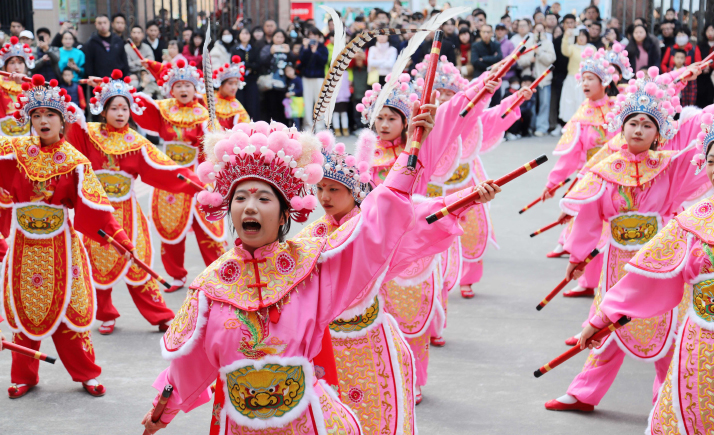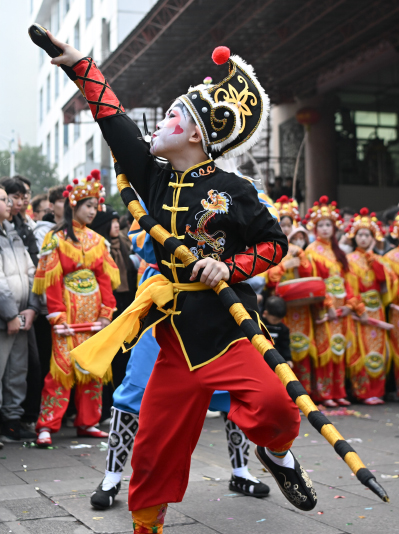| China |
| Tracing the steps of China's intangible cultural heritage from ancient tales to modern stages | |
|
|
 A member of a Yingge dance troupe performs on a street in Shantou, Guangdong Province, on January 23 A women's Yingge dance troupe performs in Shantou on January 29 (XINHUA)
With a black-and-white plush snake taller than himself in hand, 7-year-old Chen Kaiming—his face painted white and eyebrows sharply slanted with makeup—had already become a social media star thanks to his captivating Yingge dance performances before stepping into the spotlight at the 2025 China Central Television Spring Festival Gala, the highly anticipated annual event that airs on the eve of the Chinese New Year.
The Yingge dance, or "dance to the hero's song," is a folk art form that originated in Guangdong Province in south China, combining elements of opera, dance and martial arts. Over the past two years, Yingge dance has gained popularity on social media, with videos of its energetic performances amassing millions of views. In his hometown of Puning, Guangdong, Chen, despite his young age, has consistently led the dance troupe, showcasing agile and spirited moves that enchant audiences. On January 28, Chinese New Year's Eve, Chen made a remarkable appearance as the lead dancer during the opening performance of the 2025 Spring Festival Gala. Dressed in traditional Yingge dance attire and wielding a pair of drumsticks, he took center stage and became one of the evening's highlights. His performance not only dazzled viewers but also brought this over 300-year-old intangible cultural heritage back into the national spotlight, reigniting interest in its rich history and cultural importance.  A member of a Yingge dance troupe performs on a street in Shantou City, Guangdong Province, on January 23 (XINHUA)
Heroic rhythms Yingge dance performances are usually inspired by the story of The Water Margin, one of China's Four Great Classical Novels. Set during the Song Dynasty (960-1279), the novel narrates the story of 108 outlaws who gather at the Liangshan Marsh in east China to rebel against corrupt officials and oppressive rulers. Each of these 108 heroes possesses a distinct personality and set of skills, and their stories are widely known throughout China. The choreography of the Yingge dance draws from these familiar tales, using the dancers' movements, costumes and facial makeup to express the heroic spirit of upholding justice and combating evil. Incorporating elements of martial arts, the dance is often referred to as the "Chinese battle dance." According to Zheng Cheng, an associate professor at Jieyang Polytechnic in Guangdong, the art form not only showcases heroism but also embodies the essence of masculinity. Typically, the lead dancer portrays Shi Qian, a character from the novel famous for his agility and cunning. "Yingge dance has the lead dancer wielding a plush snake as the snake symbolizes flexibility and wisdom, lending the dance a sense of deep cultural significance," Zheng said. "Holding a cloth snake, the lead dancer mimics the snake's fluid movements, weaving his way through the dance troupe. His graceful steps and gestures guide the team's direction, rhythm and formation, making the performance more orderly, coordinated and visually striking." Chen was born into a family with four generations of Yingge dancers, and he has been immersed in this art form since childhood. His family's Yingge connection dates back to his great-grandfather. Chen's father said Chen showed a keen interest in Yingge dance as soon as he could walk. "The moment he heard the drums and gongs, he would start moving along," his father recalled. Puning is home to over 100 Yingge troupes, and the Nanshan Troupe, to which Chen belongs, is one of the most renowned. The first step in learning Yingge dance is mastering the Yingge sticks—two wooden rods measuring 2.8 cm in diameter and 45 cm long. Dancers hold the sticks at their midpoints, rotating them in a figure-eight motion with their wrists while using their middle, ring and pinky fingers to flick the ends, creating continuous circular movements. The popularity of Yingge dance has turned these sticks into highly sought-after items, with many enthusiasts purchasing them to practice using online tutorials. Additionally, each dancer adopts a horse-riding stance, leaping sideways while striking the sticks in sync with the rhythm of the drums. Their heads and bodies sway naturally with the beat, creating a powerful and dynamic display that exudes grandeur and heroism. During major festivals, the sound of Yingge drums fills cities and villages, contributing to a lively atmosphere. Tradition and innovation Born in 1992, Chen Yangbo from Puning was also captivated by the energetic rhythms and vigorous movements of Yingge dance from a young age. He even broke a broomstick at home when imitating wielding the Yingge sticks. "As a child, whenever the Yingge drums sounded on Chinese New Year's Day, I would joyfully follow the troupe, shouting with excitement," he told newspaper Guangming Daily. "During school breaks, my friends and I would watch VCDs of the performances repeatedly, dreaming of joining the troupe one day." But tradition dictated that only adult men could join the Yingge teams. In 2006, Puning Yingge dance was recognized as part of China's national intangible cultural heritage. To nurture the next generation of inheritors, Chen Laifa, a national representative inheritor and then head coach of the Puning Nanshan Yingge Troupe, established the Nanshan Youth Yingge Troupe. At 14, Chen Yangbo fulfilled his dream of becoming a Yingge dancer. Coach Chen Laifa challenged the traditional norms that restricted participation to adult men by launching the Yingge Dance in Schools initiative. This program introduced the art form to primary and secondary schools, and even kindergartens. Many schools have since formed female Yingge troupes. Chen Laifa told newspaper Jieyang Daily that the initiative has been well-received by parents, who believe it not only improves children's physical fitness but also reduces their reliance on electronic devices. "Traditional inheritance methods previously limited the spread of Yingge dance, particularly among younger generations," Chen Laifa said. Today, Yingge dance has embraced bold innovations in both its form and content. For example, the performance during the 2025 Spring Festival Gala retained the essence of the traditional dance while incorporating modern dance elements, making it more appealing to contemporary audiences. This year, Yingge dance teams from Guangdong were also invited to perform on multiple overseas stages as part of Spring Festival celebrations. "Yingge dance relies on wider participation from younger generations," said Lin Lunlun, former President of Hanshan Normal University in Guangdong. "Chen Kaiming's rise to fame reminds us that the preservation of intangible cultural heritage requires not only the passing down of skills but also emotional resonance and innovation that align with the times." Copyedited by Elsbeth van Paridon Comments to yuanyuan@cicgamericas.com |
|
||||||||||||||||||||||||||||
|